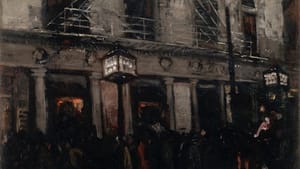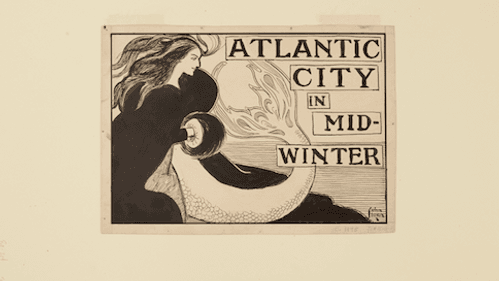Stay in the Loop
BSR publishes on a weekly schedule, with an email newsletter every Wednesday and Thursday morning. There’s no paywall, and subscribing is always free.
His journey began here
Delaware Art Museum presents 'An American Journey: The Art of John Sloan'

The Delaware Art Museum’s galleries are coated in luscious hues for An American Journey: The Art of John Sloan. Sloan (1871-1951) was more interested in color than his gritty “Ashcan” period indicates. This vivid exhibition also holds some other surprises. One is that the Wilmington institution is the world’s largest repository of Sloan’s oeuvre.
Over 2,600 artworks and 300 drawers and boxes of diaries, letters, and archival materials (including his palette and brushes) were donated by Helen Farr Sloan, the artist’s widow and a painter herself. Another surprise is that everything here comes from the museum’s collection. Some of these 99 artworks haven’t been seen since 1988, others not since the artist was alive.
Curator Heather Campbell Coyle has artfully arranged An American Journey as a chronology of places where Sloan worked: Philadelphia, New York, Gloucester, and Santa Fe. Sloan was born in Lock Haven, Pennsylvania, and the family moved to Philadelphia when he was six. His parents encouraged creativity, and the boy taught himself to etch and paint. He created his first self-portrait — he was an available, affordable model — on a window shade using his father’s oils. His serious mien and direct gaze seemed to challenge both himself and the world.
Hometown boy
In 1888 Sloan had to leave prestigious Central High School to support his family, working in Edward Newton’s “fancy goods” store designing greeting cards, calendars, and small, popular “gift books.” He became an adept illustrator, and the exhibition includes a hand-engraved business card advertising his 705 Walnut Street studio.
The Philadelphia Inquirer, and then the Philadelphia Press, snapped up the hot young artist, known for “decorative illustration” and clever Sunday supplement puzzles. Not a breaking-news illustrator churning out daily work (artist Robert Henri once quipped, “Sloan is the past tense of slow”), he had an intricate style influenced by Japanese prints and the work of Aubrey Beardsley.
Sloan also began to paint seriously, attending the Pennsylvania Academy of the Fine Arts (PAFA), where his pals included Henri, William Glackens, George Luks, and Everett Shin — the core of “The Eight” (a name they preferred to the Ashcan School), who later burst onto New York’s scene. Sloan painted Philadelphia subjects around him, including the Walnut Street Theatre (across from his studio) and the Philadelphia Stock Exchange, two cats in Green’s Hotel and Bar (a journalists’ haunt), and a portrait of Philadelphia Orchestra violinist Will Bradner.

In 1903, Sloan joined his PAFA pals in New York, where he quickly found freelance work, including illustrating an edition of Wilkie Collins’s The Moonstone. Again, he captured the world around his studio, this time in Chelsea, at Sixth Avenue and 23rd Street. Breaking with the charm of U.S. impressionists, Sloan captured urban diversity. His “New York Life” etchings reveal an eye rivaling that of Daumier or Hogarth, and his populist leanings merge with clear-eyed romanticism in “Spring Rain,” his depiction of a modern working woman.
An American artist
But An American Journey — like Sloan’s career — doesn’t end in New York. In 1914 Sloan joined painters summering in Gloucester, Massachusetts, observing there that “artists are so numerous that the cows are choking on paint rags.”
He sometimes utilized a “triads of color” theory, associating colors with musical chords, that brightened his palette. Influenced by Cézanne and other moderns, these canvases show strong brushwork, a change from the intricacies of etching and illustration. “Wet Night Washington Square” is filled with painterly strokes, subtle colors, and pinpoints of light evoking the misty evening.
The exhibition closes with works from Sloan’s visits to Santa Fe, where he summered for three decades. Fascinated with the light and landscape of the Southwest and with Spanish and Native American cultures, he experimented with oil-glazed tempera to separate color and form.
Throughout his life, the artist was also an avid diarist, writer, social commentator, and correspondent. Archivist Rachael DiEleuterio unearthed fascinating items from archives that can be viewed in detail on the museum’s website. In 1939, he wrote The Gist of Art, a hard-to-find artists’ guide, but a volume of his pedagogy is available in the museum shop along with a handsome exhibition catalogue. Programs include lectures and (on November 2 and 3, 2017) a Sloan Symposium open to the public.
Other museums have better-known or more iconic Sloan works. This is not a “greatest career hits” exhibition. It’s a retrospective of the life and work of an artist who never traveled outside the United States, a true American trajectory inspired by consistent curiosity and a shrewd intellect.
What, When, Where
An American Journey: The Art of John Sloan. Through January 18, 2017, at the Delaware Art Museum, 2301 Kentmere Parkway, Wilmington, Delaware. (866) 232-3714 or delart.org.
Sign up for our newsletter
All of the week's new articles, all in one place. Sign up for the free weekly BSR newsletters, and don't miss a conversation.
 Gail Obenreder
Gail Obenreder